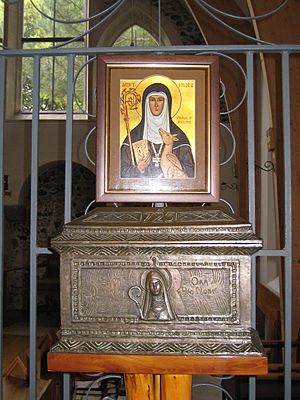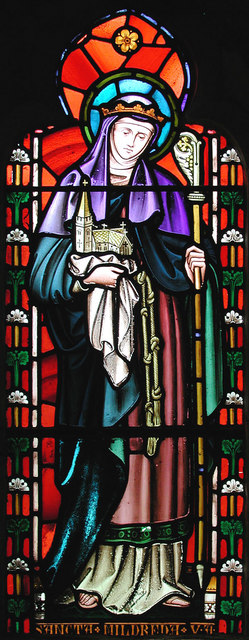Mildrith facts for kids
Quick facts for kids Saint Mildrith |
|
|---|---|
 |
|
| Abbess of Minster-in-Thanet | |
| Born | unknown, c.660 |
| Died | unknown, c.730 Minster-in-Thanet |
| Venerated in | Catholic Church Eastern Orthodox Church Anglican Communion |
| Canonized | 1388 by Urban VI |
| Major shrine | Minster-in-Thanet St Augustine's Abbey, Canterbury |
| Feast | 13 July |
| Attributes | Princess's crown, Abbess's crozier, hind |
Saint Mildrith, also known as Mildred, was an important Anglo-Saxon abbess. She lived in the 7th and 8th centuries. Mildrith led the Abbey at Minster-in-Thanet in Kent, England. After she died, she was declared a saint. Her remains were moved to Canterbury in 1030.
Who Was Saint Mildrith?
Mildrith was born around the year 660. She came from a royal family. Her father was King Merewalh of Magonsaete. This area is now known as Herefordshire. Her mother was Domne Eafe, who was also a saint. Domne Eafe was related to Æthelberht of Kent, an early English king.
Mildrith had two sisters, Milburga and Mildgyth. They were also considered saints. Mildrith and her family are part of a special story called the "Kentish Royal Legend." This legend tells about the royal family of Kent.
Mildrith was educated in Gaul, which is now France. She studied at a famous royal abbey called Chelles. Later, she joined the abbey at Minster-in-Thanet. Her mother had started this abbey. By the year 694, Mildrith became the abbess, or leader, of the abbey. She died at Minster-in-Thanet sometime after 732. She was buried in the Abbey Church of St Mary.
Her Journey and Legacy
After Mildrith died, her remains became very important. These remains are called relics. Mildrith's successor, another abbess named Eadburg, built a new church. This church was also at Minster-in-Thanet. Eadburg moved Mildrith's relics there before 748.

The shrine with Mildrith's relics became a popular place. Many people came to visit it. Mildrith became a beloved local patron saint. This means she was a special protector for the area.
In 1011, the abbey was attacked by Danes. The last abbess, Leofruna, was captured. The abbey was then abandoned. In 1030, Mildrith's relics were moved again. They were taken to St Augustine's Abbey in Canterbury. This event is remembered every year on May 18. There is even a church in Canterbury called St Mildred's Church, Canterbury. It dates back to this time.
Some of her relics were later given to a church in the Netherlands. In 1881, Pope Leo XIII officially brought back the celebration of St Mildred's feast day. In 1882, a new monastery was started at Minster-in-Thanet. The nuns there asked for some of the relics to be returned. In 1953, a relic of St Mildred was brought back to Minster.


